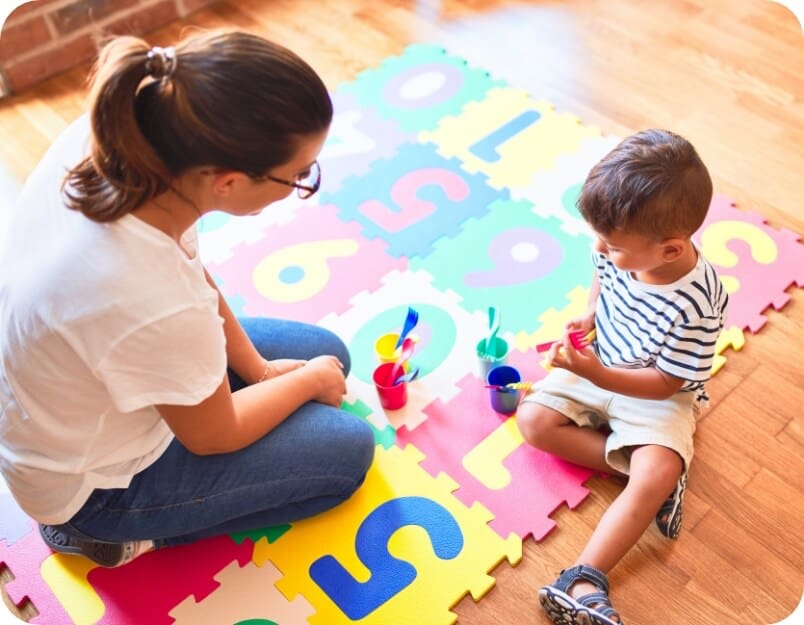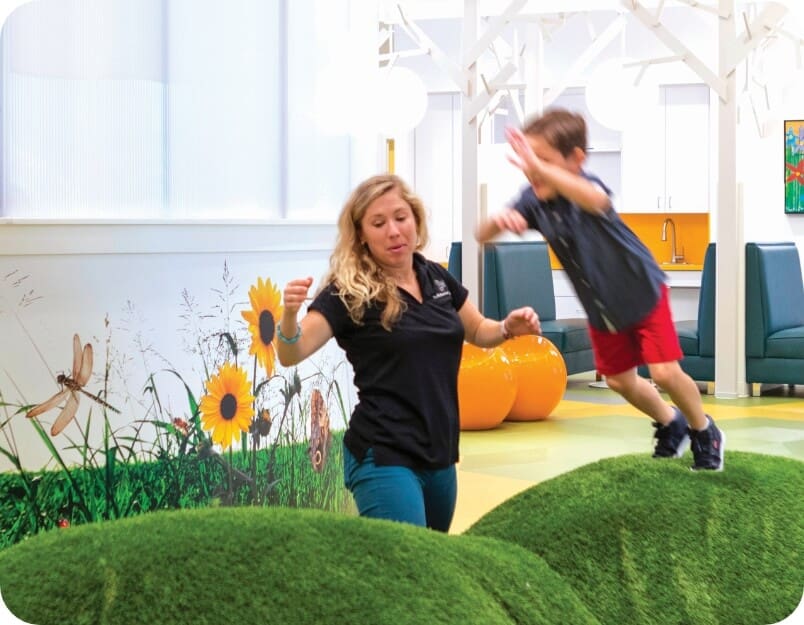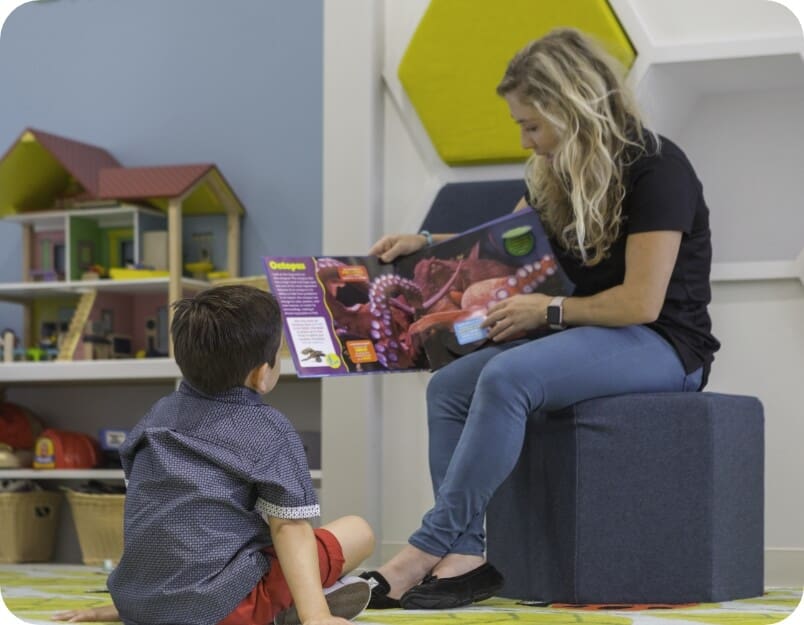One-on-One Therapy
every child is unique and we love it.
EVERY CHILD IS UNIQUE AND WE LOVE IT.
Most children who first enroll in ABA therapy at The Behavior Exchange start in One-on-One Therapy.
We provide them with highly intensive and focused therapy to help them master important skills they
can build on and continue to advance, such as compliance, instruction following, self-help and motor
skills, language, sibling relationships, age-appropriate play, and other social skills.
How It Works
One-on-One Therapy pairs one child with one of our degreed ABA therapists. The therapists work individually
with the child during sessions lasting 1-4 hours. The nature of One-on-One Therapy is highly intensive to give
children the extra time and attention they need to master specific behaviors and skills.
One-on-One Therapy pairs one child with one of our degreed ABA therapists. The therapists work individually with the child during sessions lasting 1-4 hours. The nature of One-on-One Therapy is highly intensive to give children the extra time and attention they need to master specific behaviors and skills.
There are two major styles of one-on-one therapy – discrete trial and naturalistic. At The Behavior Exchange, we take advantage of both using our proprietary curriculum. Over our 20 years of experience, we’ve developed programs that have thousands of skills and behaviors that children with autism and other learning differences are challenged to master. Discrete trial therapy teaches skills one at a time, using positive reinforcement and repetition. Naturalistic therapy, on the other hand, takes advantage of teachable moments that might occur naturally during a one-on-one session.

There are two major styles of one-on-one therapy – discrete trial and naturalistic. At The Behavior Exchange, we take advantage of both using our proprietary curriculum. Over our 20 years of experience, we’ve developed programs that have thousands of skills and behaviors that children with autism and other learning differences are challenged to master. Discrete trial therapy teaches skills one at a time, using positive reinforcement and repetition. Naturalistic therapy, on the other hand, takes advantage of teachable moments that might occur naturally during a one-on-one session.

The focus of One-on-One Therapy varies from child to child. It can range from basic skills, like responding to their name or speaking their first sounds, to more advanced areas, such as building fluency in reading, writing, and math.
Most often, One-on-One Therapy focuses on communication and language skills, visual performance and working memory, early learning and academic skills, instruction following, sibling relationships, age-appropriate play, motor and self-help skills, and interacting with peers in order to develop social skills.
The focus of One-on-One Therapy varies from child to child. It can range from basic skills, like responding to their name or speaking their first sounds, to more advanced areas, such as building fluency in reading, writing, and math.
Most often, One-on-One Therapy focuses on communication and language skills, visual performance and working memory, early learning and academic skills, instruction following, sibling relationships, age-appropriate play, motor and self-help skills, and interacting with peers in order to develop social skills.
The overall goal of One-on-One Therapy is for children to master the necessary
compliance and cooperation skills to successfully participate in group therapy that
will continue to help them reach their full potential and make friends.
The overall goal of One-on-One Therapy is for children to master the necessary compliance and cooperation skills to successfully participate in group therapy that will continue to help them reach their full potential and make friends.
Is It Right For
Your Child?
Is It Right For Your Child?
One-on-One Therapy is a great starting point for many children
who come to The Behavior Exchange.
Children typically range in age from 2-12 with varying degrees of
abilities and needs. Most lack the basic compliance and cooperation
skills to successfully participate in our Behavior Exchange Early Start
(B.E.E.S.) and Social Skills programs.
The most important thing to remember is that all children can
benefit from One-on-One Therapy, because it is intensive and
tailored to each child’s unique needs.
One-on-One Therapy is a great starting point for many children who come to The Behavior Exchange.
Children typically range in age from 2-12 with varying degrees of abilities and needs. Most lack the basic compliance and cooperation skills to successfully participate in our Behavior Exchange Early Start (B.E.E.S.) and Social Skills programs.
The most important thing to remember is that all children can benefit from One-on-One Therapy, because it is intensive and tailored to each child’s unique needs.


What You Can Expect

ABA therapy is all about measurable improvement. As our therapists work one-on-one with your child, they will constantly collect data that charts your child’s progress with each skill as well as any setbacks that impede their ability to learn. Over time, the collected data can be used to hone their therapy for even better results.
All Behavior Exchange therapists are closely supervised by a Board Certified Behavior Analyst (BCBA) to ensure children are making progress and achieving their specific goals.
ABA therapy is all about measurable improvement. As our therapists work one-on-one with your child, they will constantly collect data that charts your child’s progress with each skill as well as any setbacks that impede their ability to learn. Over time, the collected data can be used to hone their therapy for even better results.
All Behavior Exchange therapists are closely supervised by a Board Certified Behavior Analyst (BCBA) to ensure children are making progress and achieving their specific goals.
As a parent or caretaker, you’ll receive daily reports on your child’s progress as well as monthly session summaries. You’ll also be able to observe your child’s therapy sessions, meet with your child’s BCBA to discuss any concerns you have, and participate in parent training to learn how to apply ABA techniques at home.
Best of all, you will see your child making progress!

As a parent or caretaker, you’ll receive daily reports on your child’s progress as well as monthly session summaries. You’ll also be able to observe your child’s therapy sessions, meet with your child’s BCBA to discuss any concerns you have, and participate in parent training to learn how to apply ABA techniques at home.
Best of all, you will see your child making progress!
Help For You And Your Child Is
Only A Few Clicks Away
Help For You And Your Child Is Only A Few Clicks Away
Click the yellow button below to get started today! The more information you can provide the better, including digital copies of your child's diagnosis report and insurance card. Once we receive your request, we'll be in touch to schedule a consultation and tour.
Click the yellow button below to get started today! The more information you can provide the better, including digital copies of your child's diagnosis report and insurance card. Once we receive your request, we'll be in touch to schedule a consultation and tour.
